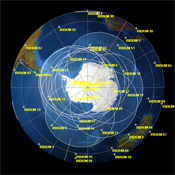|
Narrowband: Iridium Multi-Channel System (IMCS)
The main South Pole satellite systems - SPTR2, Skynet, and DSCS - provide approximately 12 hours of broadband connectivity each day. The Iridium Multi-Channel System (IMCS) was developed to provide an on/off continent data communications link to fill in the time period when the main communication satellites are not visible from the South Pole Station. The main satellite systems transport any data or voice service that can be transmitted via the USAP Enterprise network. When they are unavailable, the IMCS, which uses the Iridium satellite network, automatically activates. Due to its narrow bandwidth, the IMCS is provisioned to carry only specific critical data, such as emails less than 50 KB, critical science and weather data, and other minor data services. The IMCS uses a network router to bond 16 independent satellite voice circuits into two data channels: 10 channel link supporting Science, and 6 channel link supporting Station Operations. This advanced technology delivers a gross throughput equivalent to a home user with a 38.4 Kbps dial-up modem. The IMCS uses more than 13.5 million satellite airtime minutes each year. |
IMCS Satellite



For USAP Participants |
For The Public |
For Researchers and EducatorsContact UsU.S. National Science FoundationOffice of Polar Programs Geosciences Directorate 2415 Eisenhower Avenue, Suite W7100 Alexandria, VA 22314 Sign up for the NSF Office of Polar Programs newsletter and events. Feedback Form |



